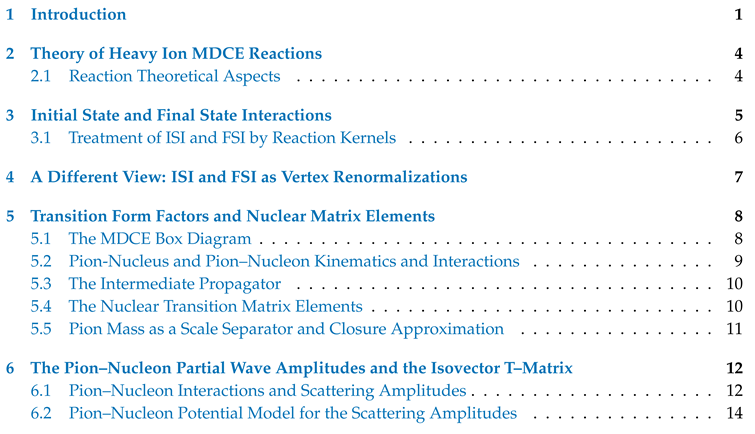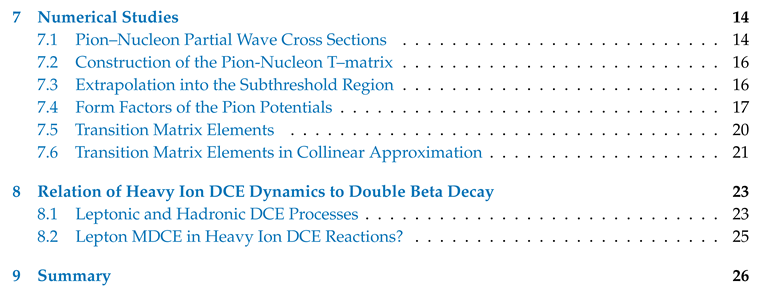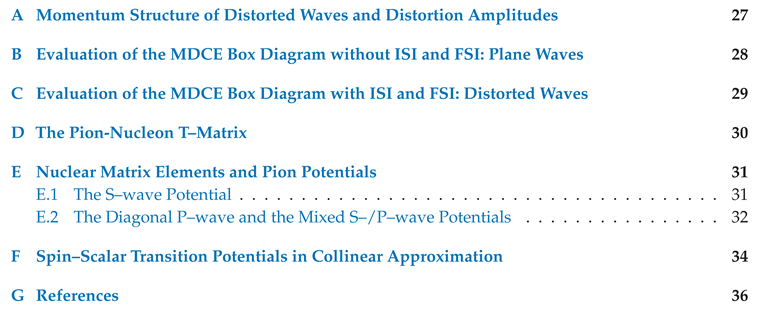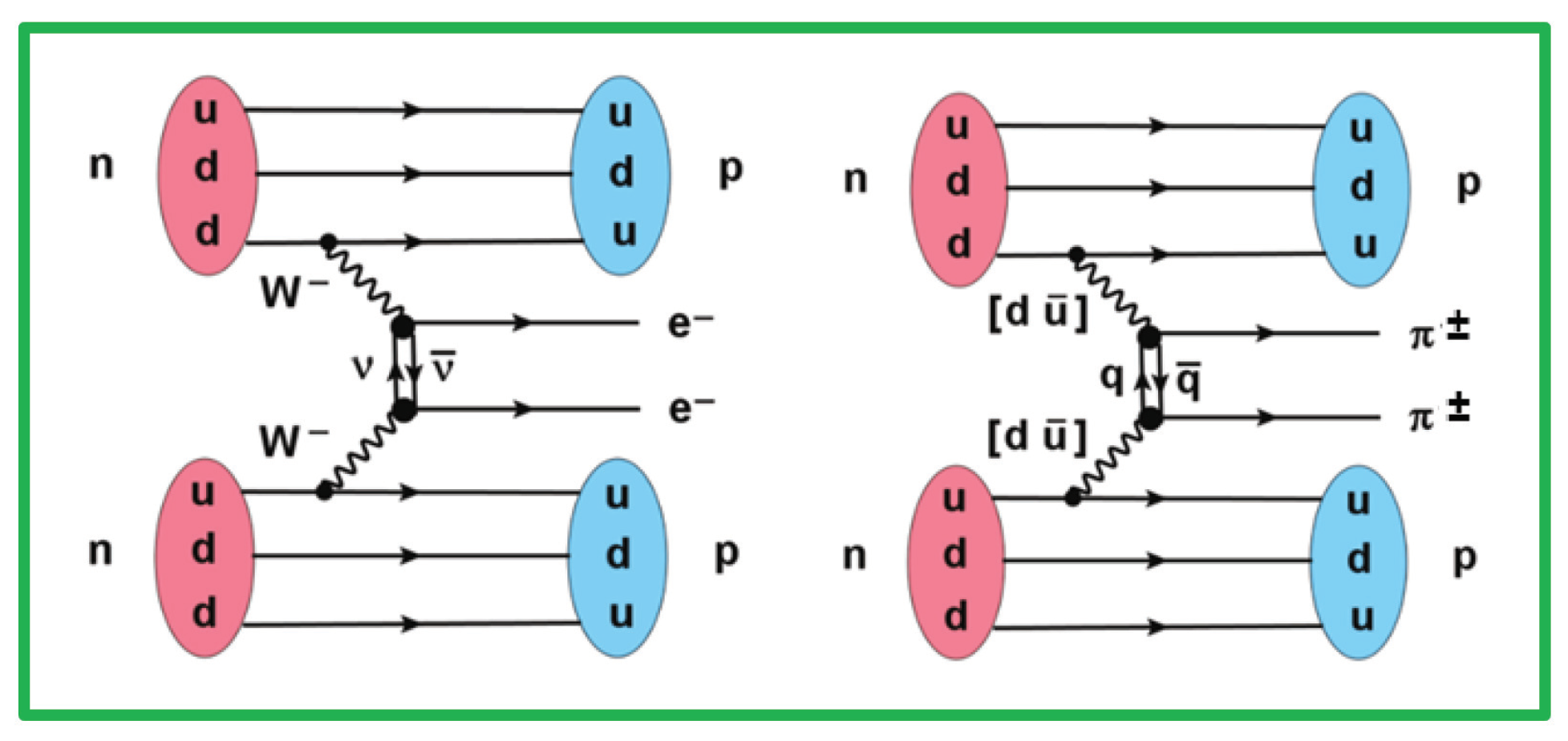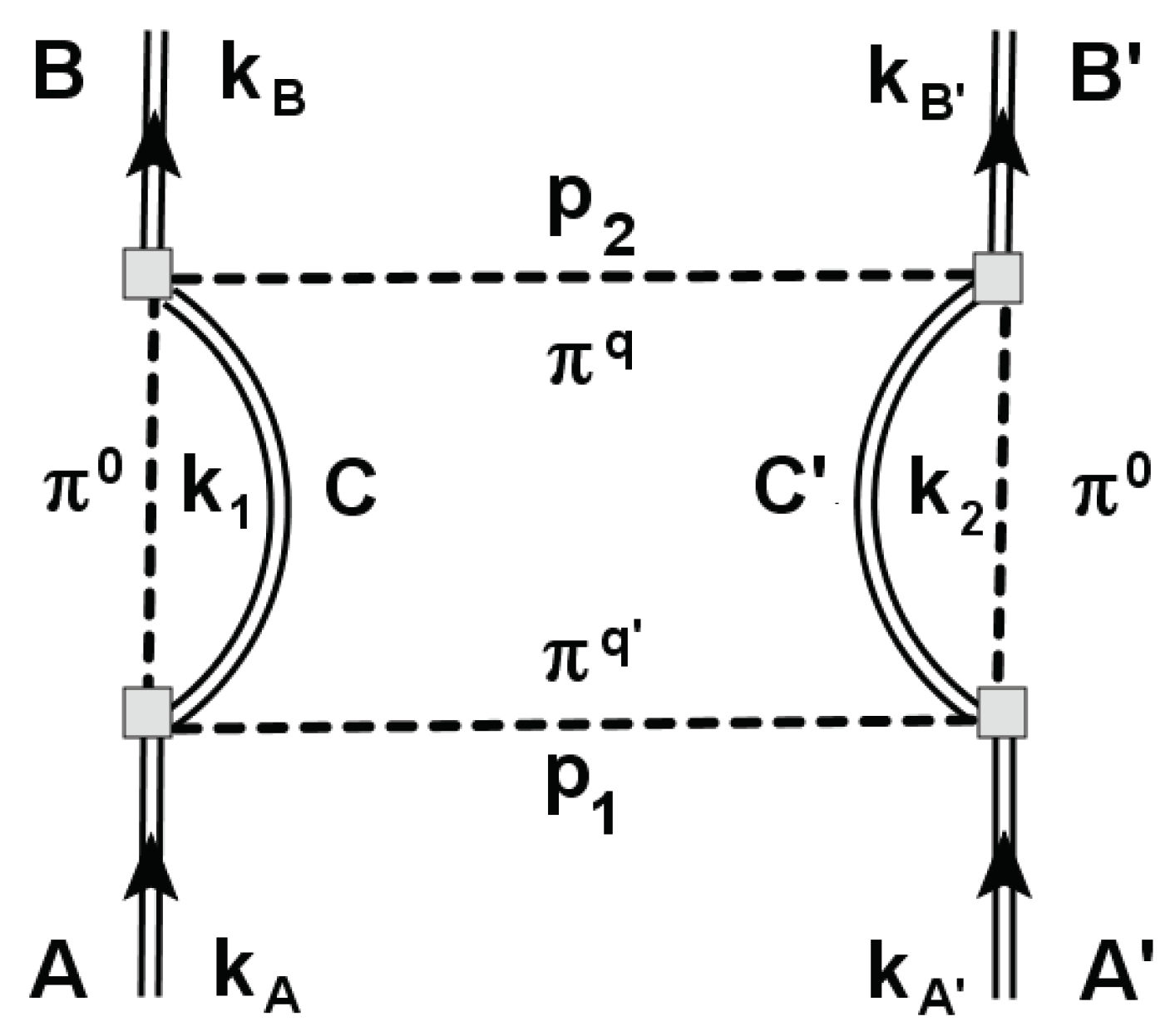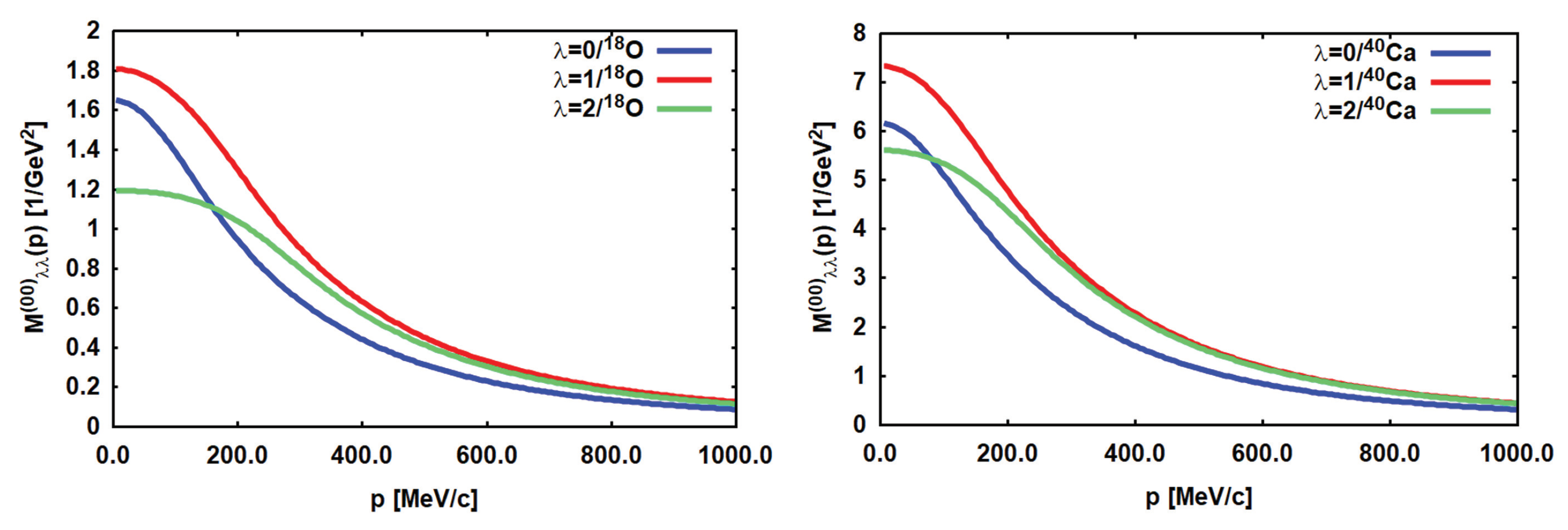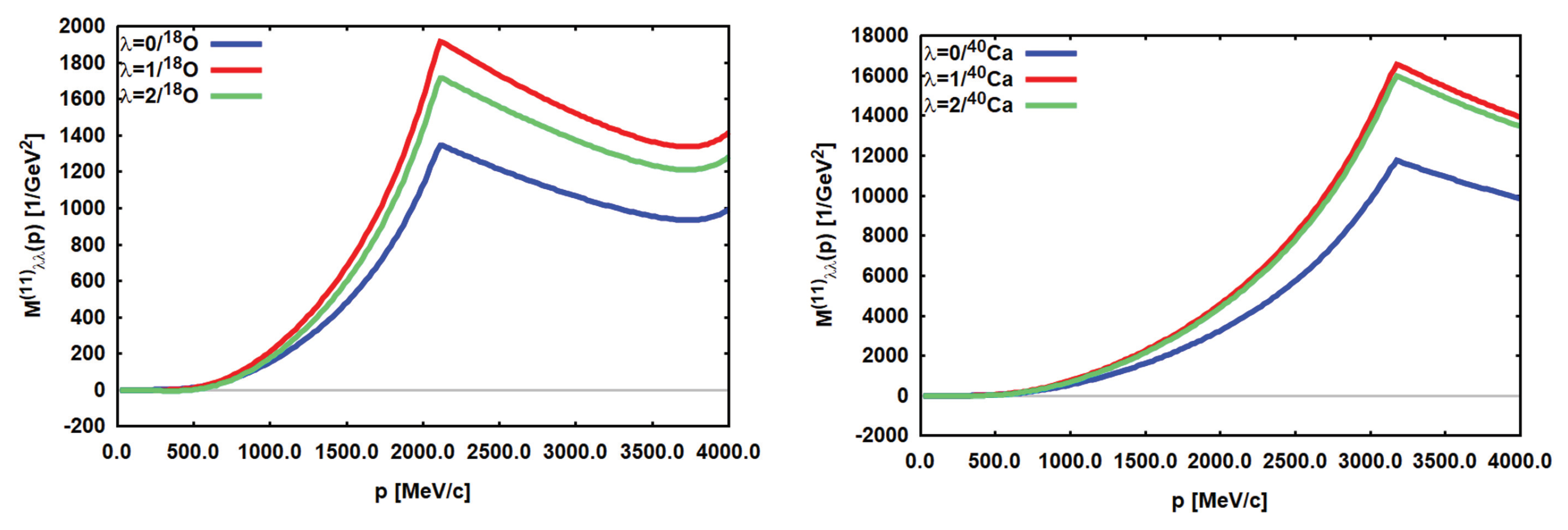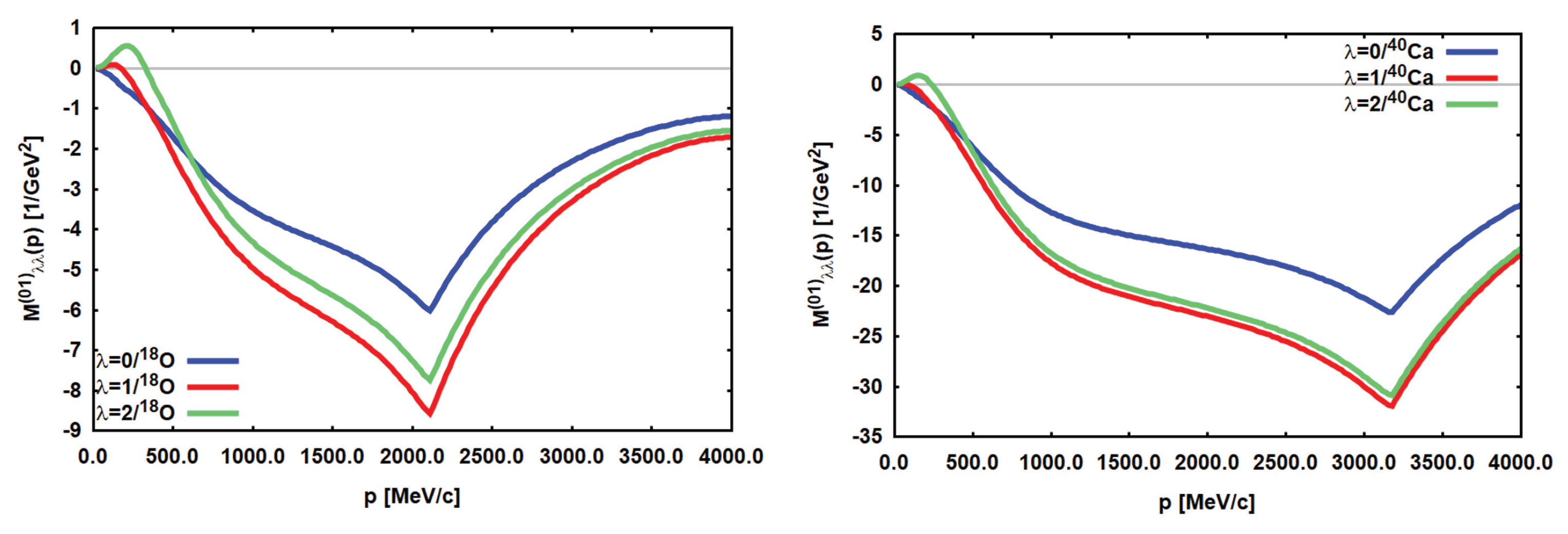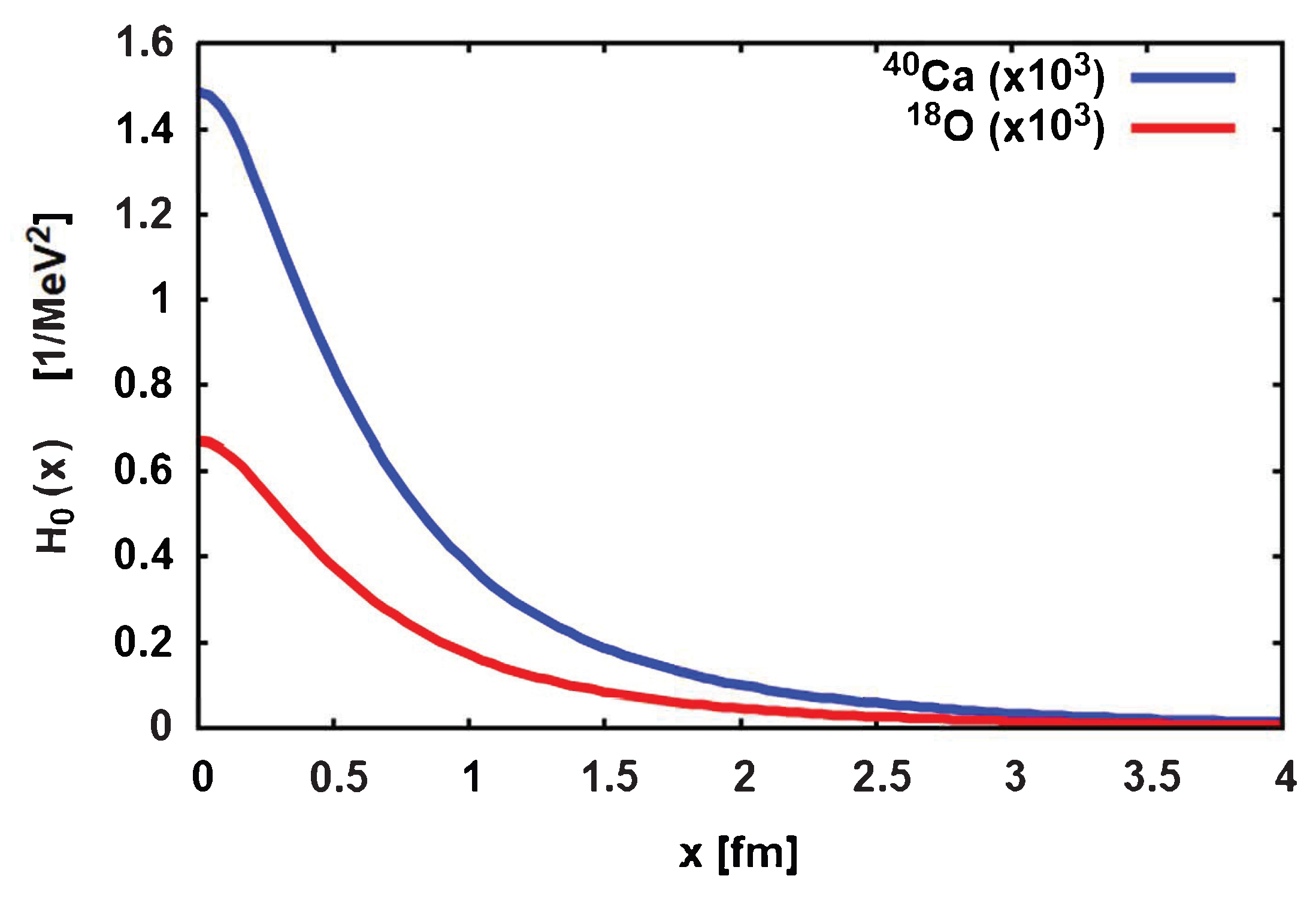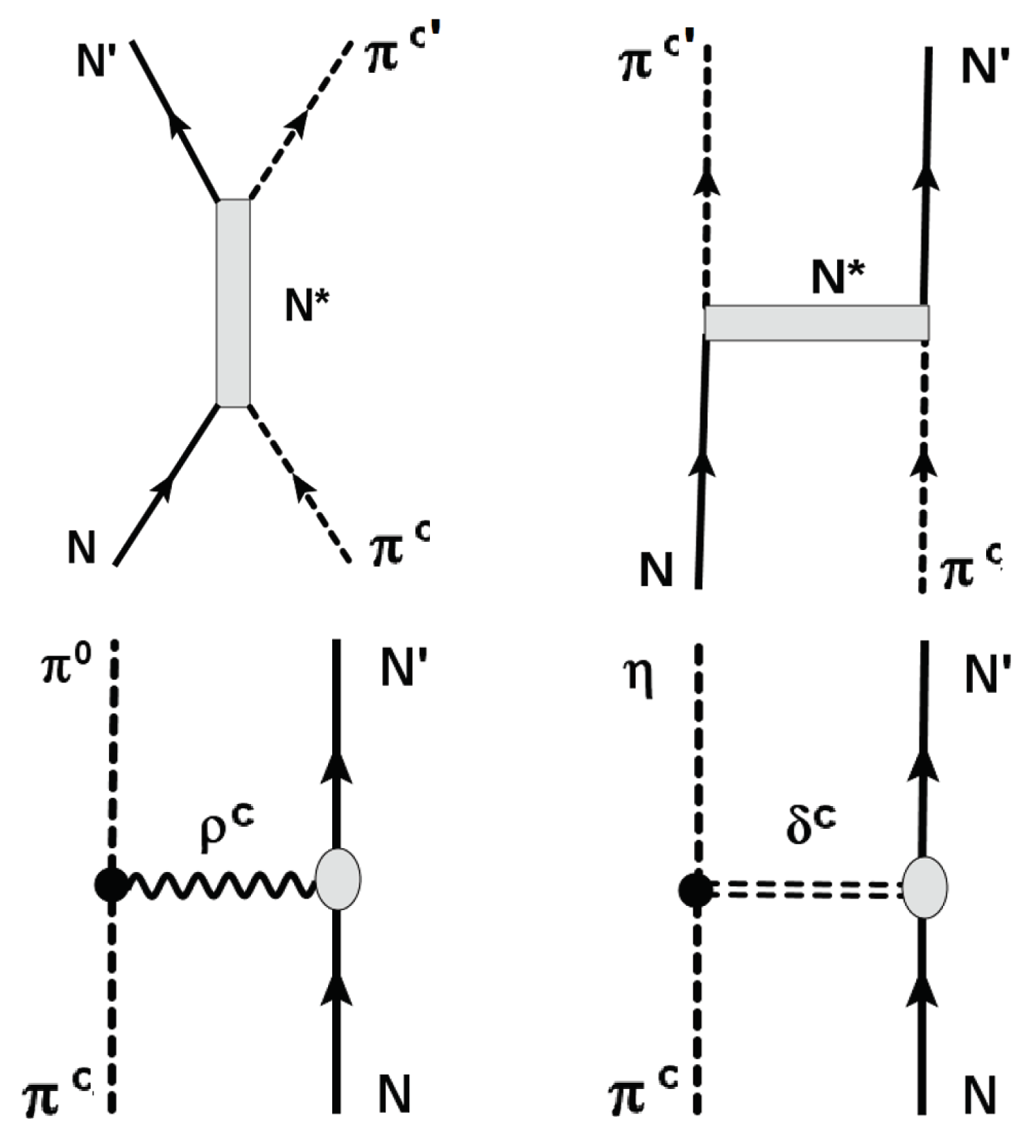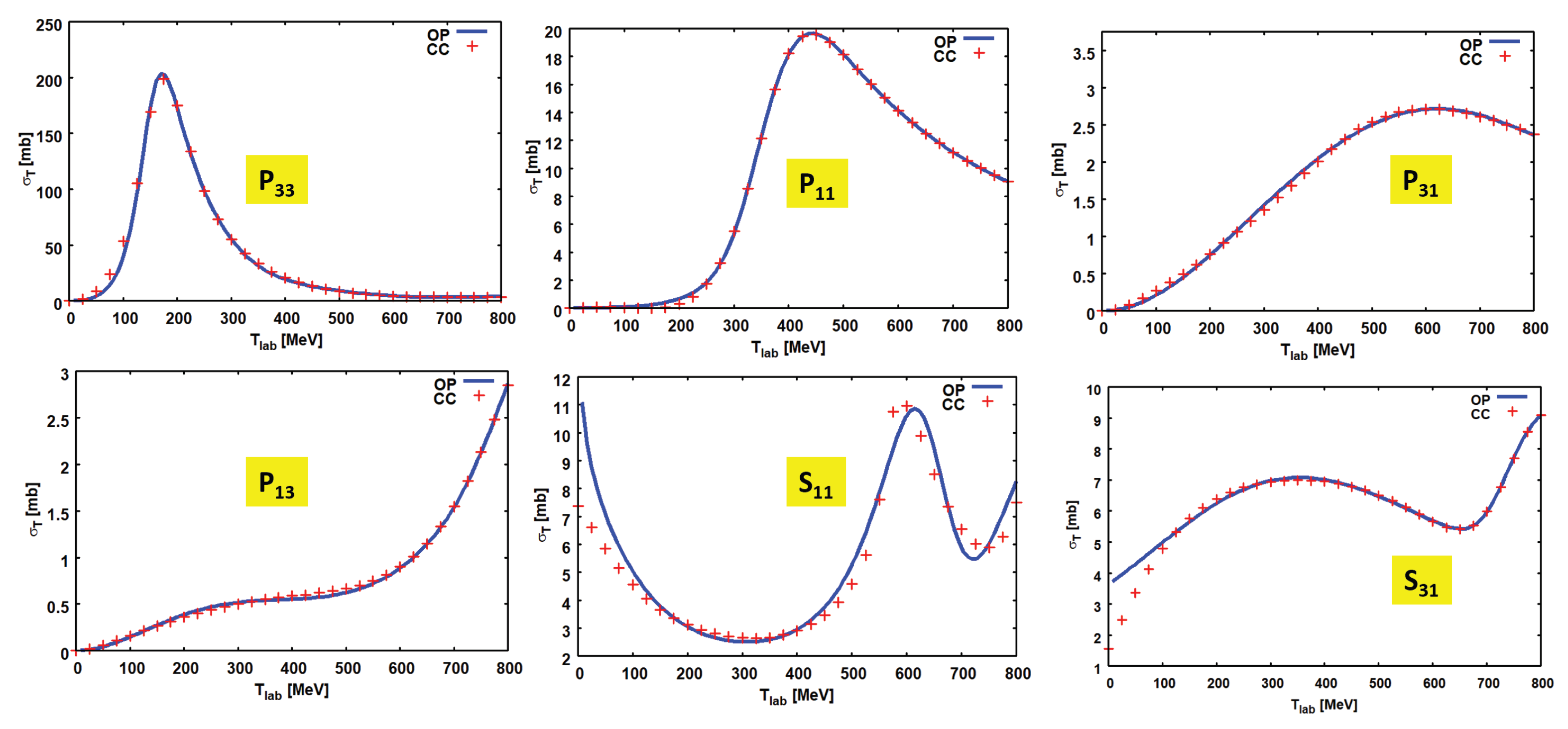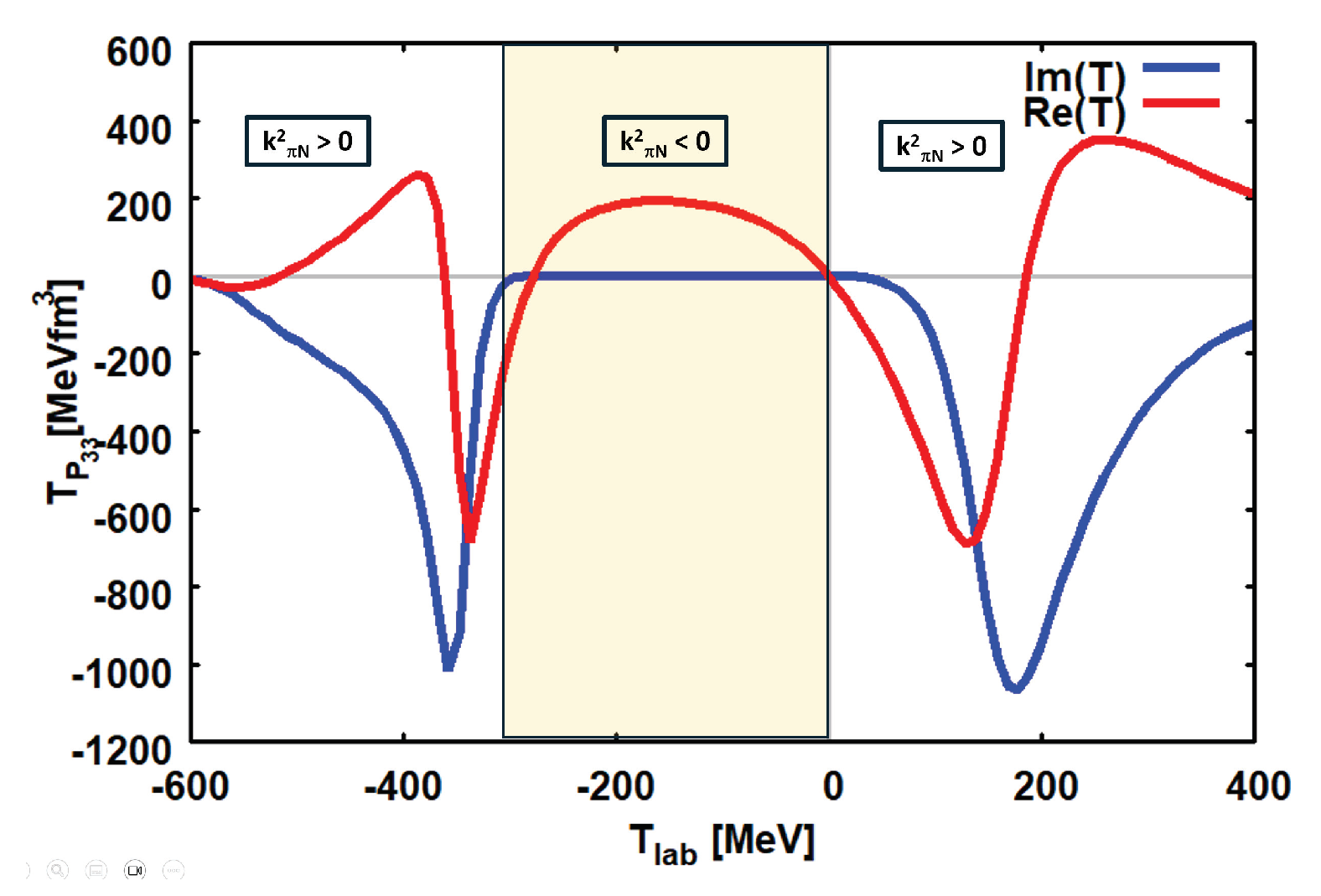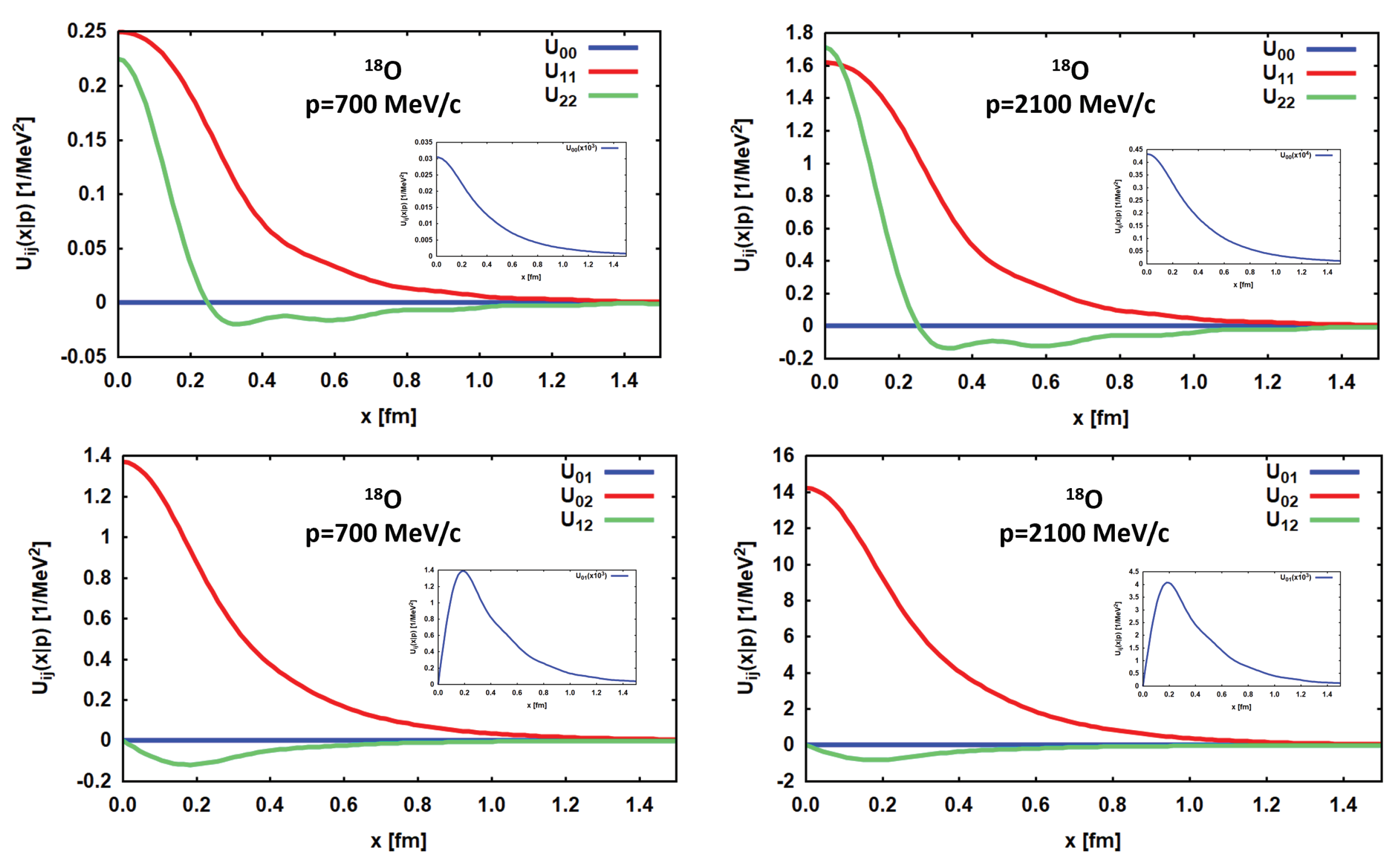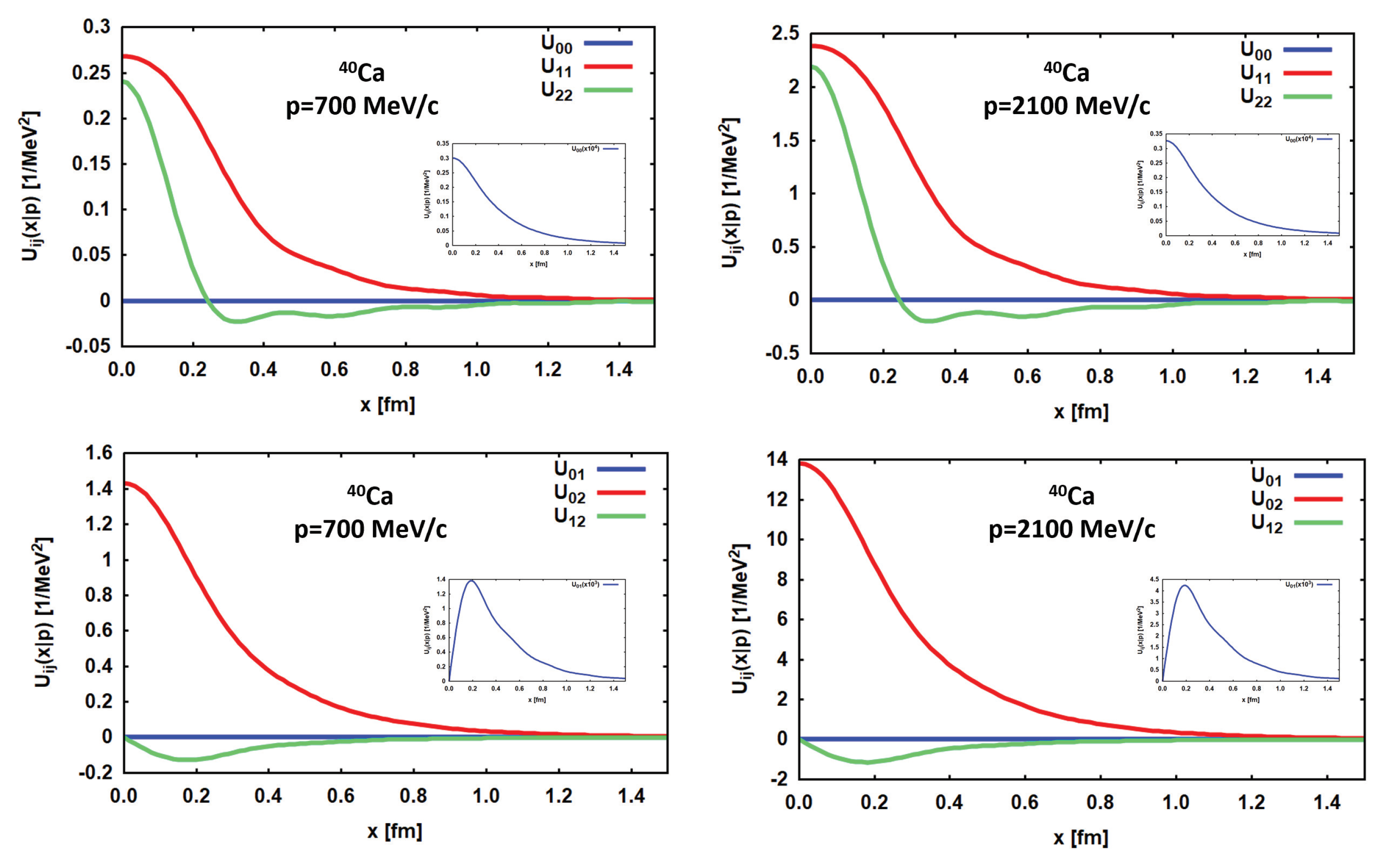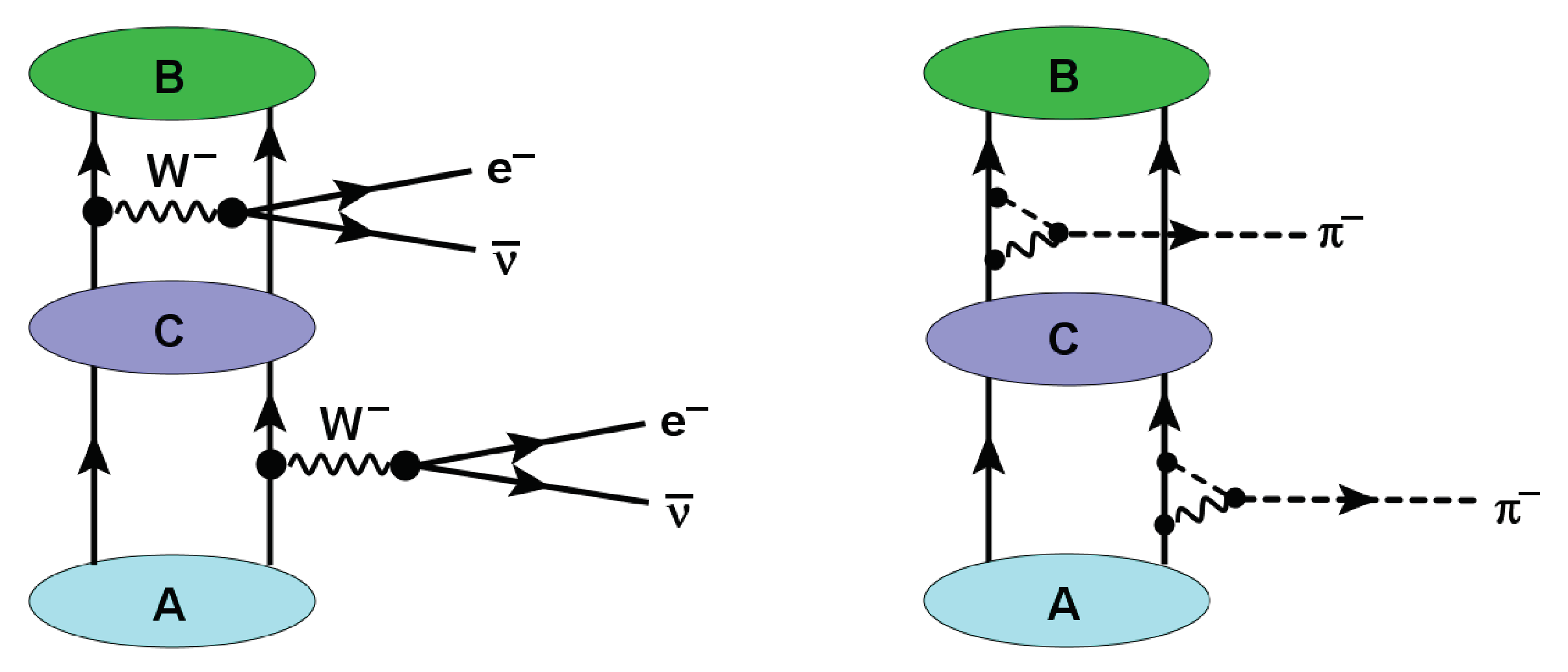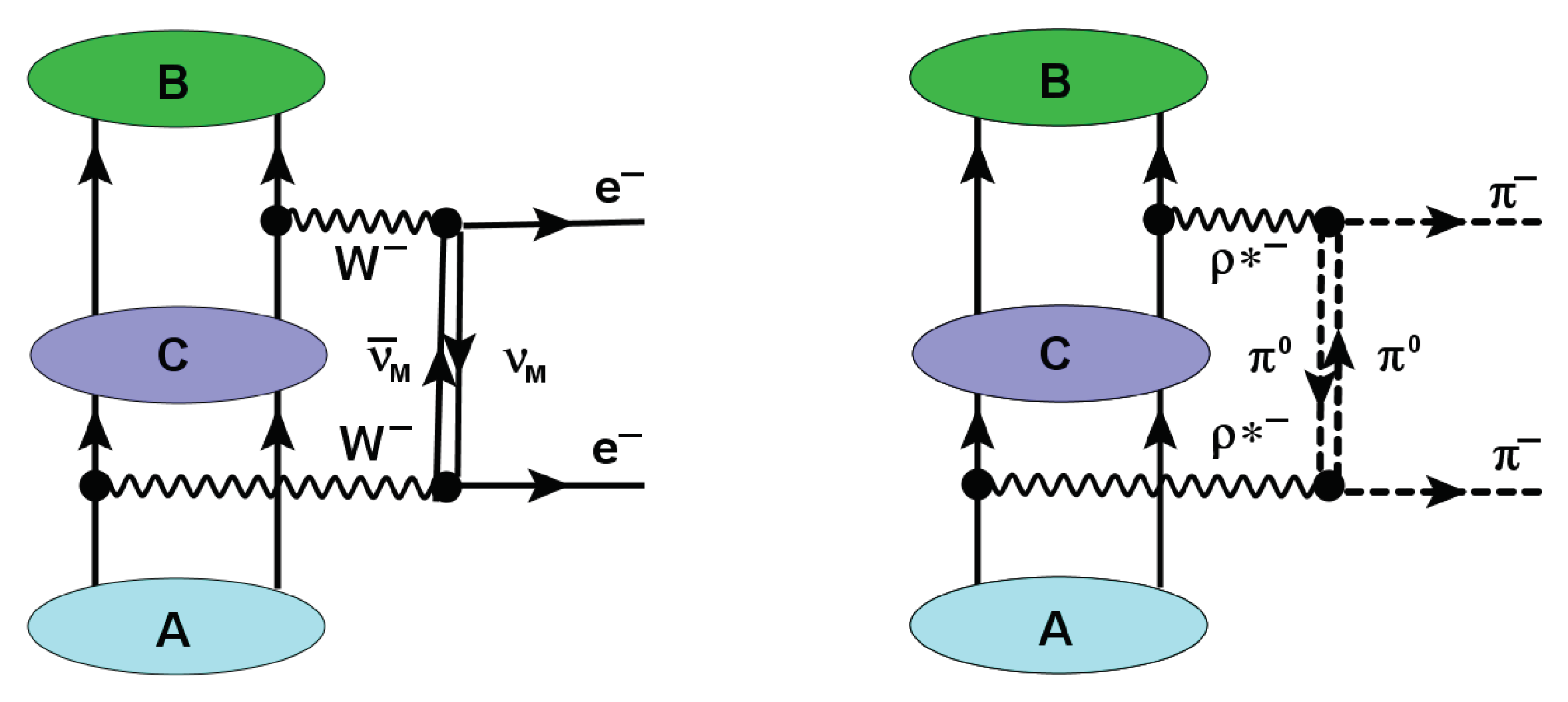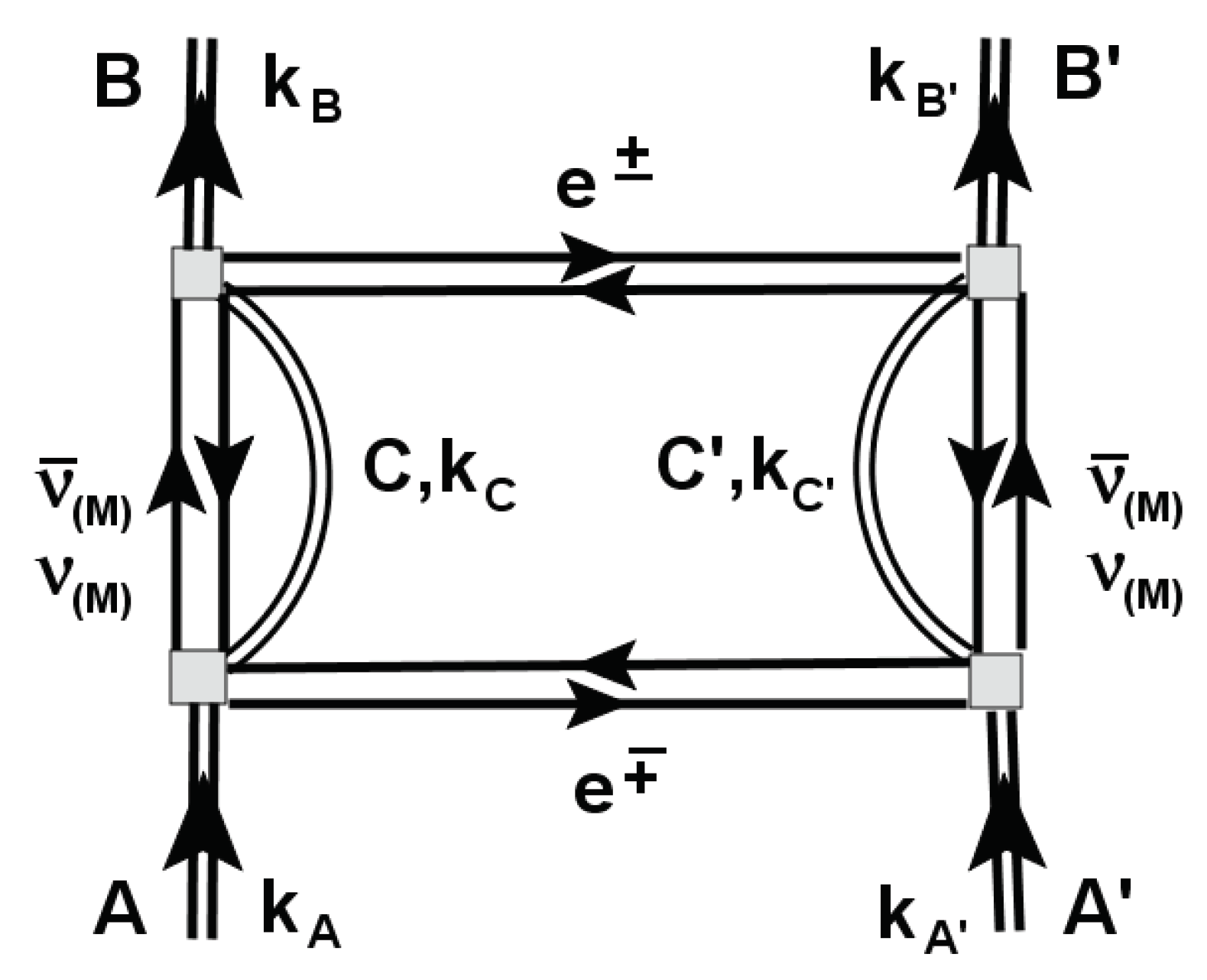1. Introduction
Heavy ion double charge exchange (DCE) reactions are unique as a new tool for investigations of the rather unexplored sector of higher order nuclear dynamics. DCE research is of generic interest for nuclear reaction and nuclear structure physics because of its large potential for high precision investigations of nuclear modes which otherwise are almost impossible to access. A central topic of this article is to show that DCE physics is going significantly beyond the standard approach to peripheral heavy ion reactions as dominated by mean–field dynamics. DCE research is located at the intersection of nuclear and hadron physics, thus broadening the view on the dynamics of nuclear many–body systems.
In a previous paper [
1] the emergence of an effective isotensor interaction and the role of ion–ion elastic interactions in second order double single charge exchange (DSCE) reactions were investigated. DSCE reactions proceed by acting twice with the nucleon–nucleon (NN) isovector T–matrix where each of the actions generates a single charge exchange (SCE) transition. It was shown that by proper transformations of the operator structures, defined by central spin–scalar, spin–vector and rank–2 spin tensor interactions, effective operators are obtained, acting as rank–2 isotensor operators intrinsically in each nucleus. In addition, in [
1] the role of initial state (ISI) and final state (FSI) ion–ion elastic interactions was investigated. The DSCE investigations led to three significant and far reaching result:
ISI and FSI interactions lead to distortion coefficients which act as quenching factors. As a result the DSCE reaction amplitude and consequently the observed DSCE nuclear matrix elements are strongly suppressed by orders of magnitudes compared to the results expected without ISI/FSI.
The relative motion degree of freedom induces in DSCE reactions in each nucleus correlation between the pair of SCE vertices where the correlation length is determined by the kinematical conditions of the reaction.
The two pairs of NN T–matrices can be recast into a set of spin–scalar and spin–vector rank–2 isotensor interactions, acting in each nucleus as effective two–body interactions and forming together a four–body ion–ion interaction.
In this work, we investigate the competing
Majorana DCE (MDCE) scenario. While DSCE theory is the second order extension of conventional direct reaction single charge exchange (SCE) theory [
2,
3], MDCE theory takes a completely different view by describing a heavy ion DCE reaction as a combination of pion-nucleon DCE reactions in projectile and target nucleus. A consequence of such an approach is that the second order aspects inherent to a DCE reaction are treated on the level of isovector pion-nucleon scattering, giving rise to dynamically created effective rank–2 isotensor interactions in projectile and target nucleus.
By definition, a heavy ion DCE reaction relies finally on an interaction of rank–2 isotensor character. Hitherto searches for such a kind of nuclear interaction of generic character have been unsuccessful. Until today, neither the existence of elementary isotensor mesons [
4,
5,
6] nor signatures of interactions of that kind in single, isolated nuclei [
7] could be confirmed with convincing certainty. Most likely rank–2 isotensor interactions do not exist as an elementary mode of its own right. The conditions, however, might change if two nuclei are in close contact as in a peripheral ion–ion collision. In such a situation, an effective isotensor interaction can be generated dynamically as a transient phenomenon. The MDCE interaction process is illustrated graphically in
Figure 2: MDCE reactions proceed by virtual pion–nucleon double charge exchange scattering, involving sequences of
and
pion–nucleon SCE reactions. Their proper combination leads finally to virtual (
) pion–nucleon DCE reactions in the reacting nuclei. Under nuclear structure aspects a DCE reaction is determined by excitations of
and
two particle–two hole configurations in the interacting nuclei.
In the past pion beams have been used extensively for DCE research on nuclei at the Los Alamos Meson Physics Facility (LAMPF) [
8]. LAMPF was shut down a long time ago but the physics issues studied there have become of new interest for heavy ion DCE research. The theoretical understanding achieved at that time for pion–nucleon isovector dynamics [
9,
10,
11,
12,
13,
14] and DCE nuclear structure theory [
15,
16,
17,
18,
19] are worth to be rediscovered because they are of high value for research on the MDCE mechanism of heavy DCE reactions.
In [
1,
20] the similarity of DSCE and two–neutrino DBD was emphasized. A special aspect of the pionic MDCE scenario is the striking similarity to the heavily discussed neutrinoless
Majorana DBD (MDBD). That similarity is illustrated in
Figure 1 on the elementary level of virtual weak
gauge bosons and highly virtual quark–antiquark
modes, the former materializing into a lepton pair on the mass–shell, the latter into a pair of meson off the mass–shell. MDBD is searched for as a possible signature for
physics beyond the standard model (BSM) because MDBD relies on the still hypothetical Majorana neutrinos with the claimed property
, see e.g. [
21,
22]. MDBD would lead to the spontaneous creation of matter in form of lepton pairs, thus violating lepton number conservation. As will be seen,the MDCE mechanism is described by graphs resembling those of neutrinoless DBD. However, MDCE is determined finally by strong hadronic interactions of a quite different range and strength. Spectroscopically the same nuclear states as in MDBD are involved and the transitions are induced by the same kind of isovector multipole operators, exciting spin-scalar and spin–vector modes.
Figure 1.
Comparison of the elementary mechanisms underlying weak neutrinoless Majorana double beta decay (MDBD) (left), leading to the creation of a lepton pair on the mass–shell, and strong Majorana double charge exchange (MDCE) leading to the emission of a pair of virtual mesons off the mass–shell. See text for further discussions.
Figure 1.
Comparison of the elementary mechanisms underlying weak neutrinoless Majorana double beta decay (MDBD) (left), leading to the creation of a lepton pair on the mass–shell, and strong Majorana double charge exchange (MDCE) leading to the emission of a pair of virtual mesons off the mass–shell. See text for further discussions.
Figure 2.
The MDCE diagram for the reaction . The isovector pion–nucleon T–matrices are denoted by filled gray boxes. The intermediate neutral pions induce a correlation between the SCE events, thus making MDCE a two–nucleon process. The co–propagating core states are denoted by and . Charged pions and , are exchanged with four–momenta between the nuclei. The four–momenta in the incident (), the intermediate (), and the exit channel () are indicated.
Figure 2.
The MDCE diagram for the reaction . The isovector pion–nucleon T–matrices are denoted by filled gray boxes. The intermediate neutral pions induce a correlation between the SCE events, thus making MDCE a two–nucleon process. The co–propagating core states are denoted by and . Charged pions and , are exchanged with four–momenta between the nuclei. The four–momenta in the incident (), the intermediate (), and the exit channel () are indicated.
In the forthcoming sections we present a concise, unified picture of the physics of MDCE dynamics and the relation to neutrinoless Majorana double beta decay (MDBD). The theoretical foundations and methods are discussed much beyond the level presented in previous publications [
3,
23]. The overall aspects, the essential features, and theoretical principles of MDCE reaction physics are presented in
Section 2. As mentioned before, the MDCE reaction amplitude is formally given by an one–step distorted wave matrix element. The quenching of reaction yields caused by the strongly absorptive ion–ion optical potential discussed in [
1] for the DSCE amplitude is less pronounced but still a highly important effect of significant strength. Therefore, the role of ISI and FSI is elucidated in
Section 3. A different view on ISI and FSI as vertex renormalization is presented in
Section 4 where we point to the formal similarity of ISI/FSI with the treatment of short–range correlations in nuclear structure calculations, used especially also in DBD theory. The MDCE transition form factors and nuclear matrix elements are investigated in
Section 5. There we also address in some detail the essential features of the box diagram, introduce the closure approximation, which allows to define second order pion potentials as effective 2–body DCE interactions. Pion–nucleon scattering and the construction of the pion–nucleon T-matrix, used to describe the excitation of
and
states, are the subjects of
Section 6. Illustrating numerical results are presented in
Section 7. Connections of DCE reactions to DBD are discussed in
Section 8. A summary and an outlook is found in
Section 9. Additional material on distortion amplitudes, details of the box diagram, the pion–nucleon T–matrix, and more on the theoretical background of the pion potentials is presented in several appendices.
3. Initial State and Final State Interactions
Before investigating further MDCE interactions and form factors, we must understand first the contributions of ISI and FSI to the reaction process. In momentum representation the MDCE reaction amplitude attains an intriguing form:
The ion–ion ISI/FSI parts are contained in the distortion coefficients
. The distortion coefficients are 3D–Fourier transforms of the incoming and outgoing distorted waves
In
Appendix A the properties of distorted wave, derived from an optical model wave equation, are investigated in detail. As the central result, the distortion coefficients are derived in closed form. On general theoretical grounds, two important results are obtained, namely that formally the distorted waves are factorizable into plane waves and residual amplitudes
, which are determined essentially by the half off–shell optical model elastic scattering amplitudes.
Anticipating the results of
Appendix A, we write
In the second equation the well known relation
was exploited, see e.g. [
24,
28,
29].
By defining the 3D–Fourier transforms
the distortion amplitudes become
For vanishing elastic interactions also the residual amplitudes vanish and the distortion coefficients approach the plane distribution
For realistic optical potentials, describing accurately ion–ion elastic angular distributions and total reaction cross sections, the residual amplitudes attain values of order unity,
, resulting in
. These results explain the pronounced quenching of the cross sections of heavy ion reactions by orders of magnitudes compared to the yields observed in reactions with particles not suffering from the strong absorption of the incoming probability flux.
3.1. Treatment of ISI and FSI by Reaction Kernels
As implied by Eq.(
10) the MDCE reaction amplitude is determined by the product of the initial and final state distortion coefficients. Together,they form the reaction kernel
From Eq.(
19) we find that the total kernel is a superposition of two kernels of the diagonal products of plane wave (PW) and DW distributions and two mixed PW/DW kernels. Combining the latter two into a single term, the MDCE kernel becomes a sum of three distinct terms
The product of plane wave coefficients defines the reaction kernel
By exploiting the properties of the Dirac delta–distributions we find the on–shell relations
and
denote the average channel three–momentum and the three–momentum transfer of the reaction, respectively.
Thus, in the plane wave limit the momenta
are fixed unambiguously by the (invariant) momenta in the initial and the final channel as derived in
Appendix B.
The ISI/FSI contributions are contained in the remaining two terms which are determined by the amplitudes of Eq.(
15). Two types of ISI/FSI distortion kernels are found:
The kernel
describes distortion effects exerted on the reaction by one of channels while the other channel is in the PW mode, i.e. ISI and FSI act separately.
accounts for the combined action of ISI and FSI. In the momentum space approach the MDCE reaction amplitude is understood as a superposition of essentially three interfering contributions of different origin and structure but of comparable magnitude:
The PW contribution reflects the bare nuclear transition matrix element before ISI/FSI renormalization. The contributions in the second line introduce ISI in the initial channel, while the exit channel is in PW mode and FSI in the exit channel, while the initial channel remains in PW mode. In the term of the last line, ISI and FSI act in both channels simultaneously.
4. A Different View: ISI and FSI as Vertex Renormalizations
A standard problem of nuclear many–body theory is to incorporate interactions from outside of the model space into the operators acting between the states in the limited model space. Formally, the projection techniques going back to Feshbach [
30] are providing first insight into the problem of induced interactions. Over the years, nuclear many–body theory has developed powerful techniques how to incorporate induced interaction as consistently as possible into all parts of the theory. Examples are many–body shell model studies of double beta decay as e.g. in [
31,
32,
33,
34,
35,
36,
37] and under slightly different aspects also in [
38,
39,
40], regarding even neutrino effective masses by induced interaction from the coupling to axions [
41]. For example, a widely used approach, introduced into DBD theory by Šimkovic et al., is the Jastrow method which implements short range correlations into matrix elements by a function, acting repulsively at small distances.
The considerations which led to Eq.(
27), are in fact following the same theoretical rationality as in nuclear structure theory, however, as will be seen in a complementary manner. In order to recognize the relationship, we recall that the model space of MDCE reactions includes the incoming and outgoing channel configurations where the incoming nuclei are assumed to be in their ground states and the outgoing nuclei are assumed to be again in their ground states or in well identified excited state. In addition the spectrum of intermediate SCE configurations will contribute. However, the intermediate states are acting mainly as a reservoir of unresolved spectroscopic strength, being responsible in the first place for generating the effective two–body interactions for transitions from the incoming nuclei to the emerging ejectiles. Thus, the explicitly treated model space contains only an extremely small subset of states of the total
configuration space. In nuclear reaction theory the respective optical potentials account for the induced interaction as far as they affect elastic scattering. Hence, to a large extent ISI and FSI correspond to induced interactions from the vast background of non–elastic channels. As known from nuclear many–body theory, once effective interactions are important in one sector, they affect also all other sectors of the theory. In particular, transition operators have to be renormalized in accordance with the renormalization scheme. In the above cited works the proper implementation of renormalization into all parts of the theory is a topic of central importance.
Reconsidering under these aspects the MDCE reaction amplitude we arrive at the conclusion that in Eq.(
27) the distortion amplitudes
are playing exactly that role, namely to renormalized the SCE vertices in agreement and consistently with the induced ion–ion initial and final state interactions. That is done in a systematic manner starting from the bare matrix element, represented by the PW amplitude, then renormalizing one of the vertices but retaining the second vertex as a bare vertex, and finally renormalizing both vertices simultaneously. Hence, ISI and FSI account for the proper renormalization of the DCE–NME under the conditions of a heavy ion nuclear reaction.
While in the nuclear structure context renormalizations typically refer to short–range effects, ISI/FSI renormalization, however, accounts for scales defined by the ion–ion self–energies, subsumed in the respective optical potentials. A decisive role is played by elastic scattering amplitude as discussed in
Appendix A. The most relevant observable, however, is the total reaction cross section as the measure for the amount of probability flux leaving the elastic channel. The redirected flux is absorbed into channels ranging from transfer channels, which are dominated by mean–field dynamics, and channels where the nuclei are excited inelastically by soft vibrational excitations and giant resonances, eventually leading to fission or fusion, to hard central collisions, possibly upending in the complete fragmentation of the incoming nuclei. Thus, renormalization by optical model interaction is of a genuine character by covering a broad range of nuclear modes and interactions from the soft to the hard scale. That mechanism is not specific for first order DW reactions as considered here. As discussed in [
1] a similar renormalization scheme is also present in the second order reactions double single charge exchange (DSCE) reaction. In DSCE reactions the matrix elements, however, are renormalized by second order distortion amplitudes.
9. Summary
A generic feature of heavy ion DCE reactions is the versatility of reaction mechanisms by which the transition from the initial to the final channel can proceed. Occasionally, the related ambiguities are considered as a severe disadvantage of research with heavy ion beams. That point of view is much too pessimistic because in reality it is of advantage to be able to investigate all facets of a physical system under the same, well defined experimental conditions and describe the results consistently by the theoretical apparatus of nuclear many–body theory. The theoretical task and challenge is to overcome the traditional separation of nuclear reaction and nuclear structure physics. Heavy ion DCE physics demands a combined approach as indispensable for any research on quantum mechanical many–body systems. In the NUMEN project this decisive aspect is realized by the multi–method approach as discussed e.g. in [
23].
In this work, we have investigated the theory of the Majorana (MDCE) mechanism which is an especially interesting part of heavy ion DCE reactions. As it was emphasized repeatedly, MDCE theory requires to go much beyond traditional concepts of nuclear reaction and structure theory. First of all, as a hitherto never considered aspect, the MDCE scenario relies on pion–nucleon dynamics which – from the beginning most likely unexpected – suddenly involves subnuclear degrees of freedom as nucleon resonances into a low–energy nuclear process. Already that aspect makes worth the efforts of investigating DCE reactions.
The MDCE process relies on a hitherto unknown mechanism, namely a dynamically induced rank–2 isotensor interaction. One of the central results was to introduce the MDCE closure approximation which allowed to derive pion potentials and two–body nuclear matrix elements connecting directly the entrance and the DCE exit channels. The pion potentials include combinations of spin and momentum scalar parts, spin–scalar longitudinal and spin–vector transversal momentum–vector components, all attached to a rank–2 isotensor operator. This rich operator structure allows wide–spread spectroscopic studies, allowing a detailed tomography of the nuclear wave functions. However, experimentally and theoretically such studies are highly demanding because they require to observe, analyse, and interpreted energy–momentum distributions over large ranges.
An especially appealing aspect of heavy ion DCE physics is the conceptional closeness to double beta decay research. That relationship was elucidated in some detail by considering the deeper levels underlying weak and strong DCE processes. They meet at the level of QCD and electro–weak physics. Clearly, neither DBD nor DCE reactions proceed at that those fundamental levels. Rather, both types of process are determined by low–energy realizations of the two fundamental theories of the current standard model of physics. However, the comparison of weak and strong DCE processes at the fundamental level is helpful to understand that nuclear DBD and nuclear DCE phenomena are finally nothing but two realizations of the same kind of fundamental processes. The differences in dynamics and strengths of DBD and hadronic DCE are due to the breaking of the fundamental symmetries in our physical low–energy environment.
As an interesting outlook to future work, the closeness of low–energy DBD and DCE physics was elucidated further by pointing to another competing reaction mechanism in heavy ion DCE reactions. Nothing forbids that MDCE reactions may proceed by the exchange of leptons. Leptonic MDCE proceeds by electro-weak dynamics but relies on diagrams of the same topology as investigated in this paper in detail for hadronic MDCE. It is left for future work to understand the dynamics and physics of lepton MDCE in detail and explore the competition of the two seemingly very different, but interfering types of weak and strong MDCE reaction mechanisms.
As a closing remark we emphasize again that in MDCE reactions are not governed by NN interactions as is the case for DSCE reactions. MDCE reactions are determined by pion–nucleon interactions which provide the required isospin operator structures for an effective rank–2 isotensor interaction. In MDCE reactions the colliding ions generate dynamically their own and specific isotensor interactions. Charge and baryon number conservation and isospin symmetry require that a transition in one nucleus must be accompanied by a transition in the other nucleus. Obviously, all of the involved transitions are allowed and possible by strong nuclear interactions. Hence, hadronic DCE is not suppressed or even forbidden by violating fundamental laws of the standard model as required for decay. While MDBD is constrained trivially to appear on the mass shell, MDCE reactions take advantage of the presence of another nucleus which gives access to a broad spectrum of off–shell processes and new research opportunities. Hence, it depends on our theoretical and experimental skills to identify and prepare the proper conditions under which rare hadronic or even leptonic MDCE events will become observable.
Appendix A. Momentum Structure of Distorted Waves and Distortion Amplitudes
With ISI and FSI, the momentum relation are changed because the diffractive and absorptive interactions of the optical potential
admix a certain amount of off–shellness into the theory, a seen immediately by expressing the distorted waves by their integral equation, e.g.
and
are plane waves and
are the kinetic energies defined by the momenta
,
. Thus, a finite range optical potential will always lead to a wave functions with a momentum distribution centered at the physical asymptotic momentum
but with a finite width which in leading order is determined by the 3D-Fourier transform of the potential.
As anticipated in
Section 3 the distorted wave may indeed by cast into the form
and referring to Eq.(
A1) we derive
where we changed to the coordinate representation
.
Now we are at the position for gaining further insight into the meaning and physical content of the distortion coefficients:
where we have introduced
and the Cauchy decomposition of the energy denominator was used. The distortion amplitudes defined in Eq.(
15) are identified as the Fourier transform
Finally, we note that on the momentum shell
, defined by the pole part of the energy denominator, we retrieve the optical model elastic scattering amplitude,
where
.
Appendix B. Evaluation of the MDCE Box Diagram without ISI and FSI: Plane Waves
The total available energy in the rest frame of the incident
system is defined by the sum
of the four–momenta
of the incoming ions, leading to the Lorentz–invariant Mandelstam energy
and by energy–momentum conservation
. In the laboratory frame with a beam of ions with rest mass
impinging with kinetic energy
on the target nuclei with rest mass
the invariant energy is defined by
. In the rest frame the ions carry the four–momenta
with the invariant relative three–momentum and energies
The outgoing ions
leave the interaction zone with four–momenta
. In the rest frame they are given by
The reaction proceeds by momentum transfers in the t–channel
and in the u–channel
, leading to the well known invariants
and
. Together with the invariant total energy we retrieve the well known Mandelstam relation
The charged pions are exchanged in the t–channel with momenta
Hence, we find
and the t–channel and s–channel momenta are related by
Summing the squares of these relation, the Mandelstam relation, Eq.(
A11), is recovered but now expressed by the internal momenta of the box diagram. Since the four internal momenta of the box diagram are constrained by three invariants, we realize that the initially four independent momentum integrals have collapsed to a single momentum integration. A meaningful choice is to use one of the t–channel momenta as the independent variable, e.g.
.
Considering the reaction in the ion–ion rest frame, in the plane wave (PW) limit the momenta are fixed by Eq.(
22), from which we find immediately:
and ,
and ,
ia purely space–like four–momentum,
includes formally the Q-value of the DCE reaction,
and are fixed by the three–momenta of the incoming and outgoing systems,
is a purely time–like four–vector,
is a purely time–like four–vector.
Thus, in the PW limit the intermediate s–channels have available the energies and , showing that in the PW limit all momenta are known.
Dynamically, the intranuclear DCE transitions are given by sequential pion–nucleon SCE reactions, meaning that finally we have to resolve the intermediate configurations into their pion–nucleon substructures. The frost step is to recognize that the invariant energy available for the
configurations is defined by the purely time–like four–vector
. Thus, energetically
defines the on–shell conditions. In their rest frame the pion and the SCE–excited nucleus
C are moving with the invariant three–momentum
. Their four–momenta are
and
and
. On the pion–nucleon level, we have available in the average the energy
from which obtain as before the relative pion–nucleon momentum
,
. As a side result we find the equivalent (fictitious) pion energy in the laboratory frame,
which attains positive values as long as
. However, depending on the energy of the initial
–system, we may encounter
and consequently
, thus entering into the sub–threshold region. Classically, that energy region is of course forbidden, but not in quantum mechanics which, however, also inhibits to explore experimentally the below–threshold regions. The pion–nucleon interactions become virtual processes, governed by
which is located outside of the physically accessible region. Hence, it is the task of theory to provide a description which allows to extend
from the experimentally accessible regime into the sub–threshold energy regions encountered for pion–nucleon interactions in nuclear reaction like a heavy ion DCE reaction.
Obviously, there is no unique choice for (virtual) pion–nucleon kinematics under the conditions of a heavy ion reaction. The DCE reaction in total is a highly dynamical process and as such corresponds to sampling over many different configurations. The mean energy approach sketched above takes that in to account in the average.
Appendix C. Evaluation of the MDCE Box Diagram with ISI and FSI: Distorted Waves
A realistic description of heavy ion DCE reactions requires of course to include elastic ion–ion interactions. With ISI/FSI the interacting ions occupy regions of the configuration space beyond the on–shell point. In the ion–ion rest frame the off–shellness is defined by the distribution of the three–momenta
around the respective on–shell momenta
. The width and shape in general of the distribution is controlled by the distortion amplitudes
. According to
Appendix A, Eq.(
A7), for a known optical potential, modelling the elastic ion–ion self–energies, the distributions are unambiguously known as determined by the half off–shell elastic scattering amplitudes of the incoming and outgoing ions.
Hence, ISI and FSI dissolve the strict momentum relations of the PW limit. This process, however, is of a purely virtual character which introduces a dynamically generated uncertainty in the three–momenta but does not alter the conserved energy. Hence, in the ion–ion rest frame, A and carry momenta while the on–shell energies are retained. Accordingly, the exit channel is described by , .
As a result, also the intermediate pion–nucleus, and consequently the pion–nucleon, channels are affected because
depend on the virtual momentum
. Thus,
and
depend on
. Since the MDCE reaction amplitude, Eq. (
10), is given finally by integrations over the virtual momenta
, the reaction
proceeds as a sampling over a distribution of off–shell nuclear transition form factors, The distribution, however, is centered at the on–shell form factor which is directly related to the MDCE nuclear matrix element.
Appendix D. The Pion-Nucleon T–Matrix
The form factors
,
, of the pion-nucleon T–matrix, Eq.(
9), are given by the partial wave amplitudes. The The
component is given by formation of
S–wave
resonances
of negative parity with isospin
and total angular momentum
. The form factors
of the longitudinal and transversal parts originate from
configurations of positive parity with isospin as before but
. The most prominent P–wave resonances are the Delta and the Roper resonances with spectroscopic notations
and
, respectively.
At the energies considered here, MDCE reactions take place off the pion-nucleon mass shell. Hence, pion-nucleon scattering must be described by methods allowing to extrapolate into off–shell energy regions. That goal is achieved by appropriately modelling the pion self–energies with analytically given complex–valued form factors where parameters are adjusted to on–shell observables which in our case are partial wave cross sections. In order to obtain converged below–threshold results, in practical calculations resonances up to the mass region of about 2 GeV must be taken into account.
The vertex form factors of the isovector pion–nucleon T–matrix are obtained from the scattering amplitudes
in the various pion–nucleon channels by proper isospin coupling. The pion–nucleon scattering amplitudes are measured (and calculated) in the particle basis
,
,
, and
, respectively. The pion–nucleon states are transformed to the isospin basis by Clebsch–Gordan coefficients.For example,
where
and in above case we have
. The scattering amplitudes in the particle basis are set equal to the matrix elements which are obtained in the isospin basis for the isoscalar and the isovector interactions. The pion–nucleon T–matrix
is an isospin invariant operator and as also are the matrix elements. The isoscalar and isovector operator form of the T–matrix is finally obtained by inversion from the scattering amplitudes in the particle basis. The procedure is discussed e.g. in [
55]. The result is
The factors of
and
are resulting from the isospin Clebsch–Gordan coefficients.
The scattering amplitudes are normalized to units of . With the the kinematical factor the T–matrix amplitudes are normalized to units of MeVfm. is the pion–nucleon reduced mass. denotes the invariant relative pion–nucleon momentum which is determined by the invariant Mandelstam energy .
Appendix E. Nuclear Matrix Elements and Pion Potentials
In closure approximation, the TME are given in general by a superposition of nine terms
is the nucleon rank–2 isotensor operator and
denotes the pion counter apart. The distance between the two SCE–vertices, i.e. the distance between the participating nucleons, is
.
The three diagonal potentials are
As seen below,
and
, respectively, are scalar forms giving rise to spin–scalar double excitations of Fermi–character (FF).
is a dyadic vector form featuring spin–vector double excitations of Gamow–Teller type (GG).
The two non–diagonal terms inducing FF–modes are
The remaining four non–diagonal terms are of mixed spin character inducing FG– and GF–modes, respectively:
Appendix E.1. The S–wave Potential
The diagonal S–wave potential is easily evaluated:
with the scalar monopole form factor
where
is Riccati–Bessel function of order
ℓ. Numerically, the form factor resembles a regularized Yukawa potential, as seen in
Figure A1. The magnitude of
is defined
, see Eq.(
29).
Figure A1.
The S–wave form factor
for
Ca (blue) and
O (red). The full propagator, Eq.(
29), was used. See text for further discussion.
Figure A1.
The S–wave form factor
for
Ca (blue) and
O (red). The full propagator, Eq.(
29), was used. See text for further discussion.
Appendix E.2. The Diagonal P–wave and the Mixed S–/P–wave Potentials
The mixed S–/P–wave potentials and the diagonal P–wave potentials are evaluated by expressing the momentum vectors in spherical coordinates, see e.g. [
1]. The spherical basis is defined by the bi–orthogonal set of unit vectors
,
:
The vector products are
where the Levi–Civita tensor is evaluated with
. In that basis, space–like three-vectors
are given by:
where
A particular useful result is that the spherical components of
can be expressed in terms of spherical harmonics
where
and the rank–1 spherical harmonics
,
, describes the orientation of
in 3D–space.
In the mixed S–/P–wave potentials and in the diagonal P–wave potentials we encounter monadic and dyadic structures of tensorial rank 1 and rank 2, respectively:
In the spherical basis, the tensors become
The rank–2 tensor is treated accordingly but leads to a more involved structure:
with the dyadic products
The multipole form factors are
with the radial form factor
The parity coefficient
vanishes if
is an odd number. A collection of Clebsch–Gordan coefficients is found in Tab.
Table A1. Other values of relevance for the present purpose are obtained readily by means of the symmetry relations
and also
Table A1.
Short table of Clebsch-Gordon coefficients.
Table A1.
Short table of Clebsch-Gordon coefficients.
|
|
|
|
| 0,0 |
0,0 |
0,0 |
1 |
| 1,0 |
1,0 |
0,0 |
|
| 1,1 |
1,-1 |
0,0 |
|
| 1,0 |
1,0 |
2,0 |
|
| 1,1 |
1,-1 |
1,0 |
|
| 1,1 |
1,-1 |
2,0 |
|
| 1,1 |
1,0 |
2,1 |
|
| 1,1 |
1,1 |
2,2 |
1 |
The diagonal P–wave transition potentials are given by:
and
The mixed S–/P–wave transition potentials are
Appendix F. Spin–Scalar Transition Potentials in Collinear Approximation
In the collinear limit it is mathematically of advantage to include the plane wave factors into the potentials. The modified spin–scalar transition potentials were introduced in Eq.(
59). They are given by
where
. By a proper change of integration variables
we find the transition potentials
with the integration kernels
We define
, express powers of t by sums of Legendre polynomials
, use the addition theorem of spherical harmonics, and find
The two–body potential obtained from the double P–wave amplitude contains the polynomial
which is converted to
The propagator is expanded accordingly in spherical harmonics:
Since the kernel of the double S–wave potential is identical to the propagator, we already found the multipole expansion of
. The multipoles of the kernels involving P–wave amplitudes are found by combining Eq.(
A65) with the corresponding polynomial pre–factors. Formally, the final results are of a similar structure:
However, the multipole form factors are of a more complex form. The mixed S–/P–wave form factor is
and in the double P–wave case we find
The coefficient
defines the parity selection rule that
must be an even number.
Finally, the plane wave is expanded into partial waves in the coordinates
. Separating spherical harmonics depending on the momenta, we find
The angular integration can be performed in closed form and we find:
For
the two–body potentials simplify to the operator
The multipole kernels are
The spin–vector potentials
,
, and
can be evaluated by the same techniques, but additional work is need for the proper treatment of the vector products, for which the formalism of
Appendix E will be found useful.
Figure 3.
Pion-nucleon isovector interactions either by the formation of resonances in elastic s–channel scattering (upper row, left) or by t–channel exchange (upper row, right) and t-channel vector–isovector meson (lower row, left) and scalar–isovector meson exchange (lower row, right).
Figure 3.
Pion-nucleon isovector interactions either by the formation of resonances in elastic s–channel scattering (upper row, left) or by t–channel exchange (upper row, right) and t-channel vector–isovector meson (lower row, left) and scalar–isovector meson exchange (lower row, right).
Figure 4.
Excitation of or SCE particle–hole configurations by pion-nucleon isovector interactions through meson exchange (left and center) and formation and decay of resonances (right). The conversion via delta–meson exchange shown in the center indicates that the intermediate meson could also be an meson.
Figure 4.
Excitation of or SCE particle–hole configurations by pion-nucleon isovector interactions through meson exchange (left and center) and formation and decay of resonances (right). The conversion via delta–meson exchange shown in the center indicates that the intermediate meson could also be an meson.
Figure 5.
Total partial wave cross sections for P–waves and S–waves. Cross sections obtained with the pion–nucleon optical potential model (OP) are compared to coupled channel results (CC). In the upper row, (left), (center), and (right) are shown, in the lower row , , and cross sections are displayed as functions of the pion energy in the laboratory frame. The Delta resonance at MeV and the Roper resonance at MeV are well reproduced. The low–energy tail of the resonance is visible at the end of the displayed cross section. The resonance sticks out as rather narrow structure at MeV. Note the differences in scales.
Figure 5.
Total partial wave cross sections for P–waves and S–waves. Cross sections obtained with the pion–nucleon optical potential model (OP) are compared to coupled channel results (CC). In the upper row, (left), (center), and (right) are shown, in the lower row , , and cross sections are displayed as functions of the pion energy in the laboratory frame. The Delta resonance at MeV and the Roper resonance at MeV are well reproduced. The low–energy tail of the resonance is visible at the end of the displayed cross section. The resonance sticks out as rather narrow structure at MeV. Note the differences in scales.
Figure 6.
(left) and (right) partial wave scattering amplitudes. Real and imaginary parts from the potential model (OP) are compared to coupled channels (CC) results. Note that the OP parameters were fitted to total cross sections, defined by the imaginary part of the scattering amplitude, .
Figure 6.
(left) and (right) partial wave scattering amplitudes. Real and imaginary parts from the potential model (OP) are compared to coupled channels (CC) results. Note that the OP parameters were fitted to total cross sections, defined by the imaginary part of the scattering amplitude, .
Figure 7.
The T–matrix in the kinematical regions relevant for MDCE reactions. Real and imaginary parts from the potential model (OP) are shown for energies above threshold, , , and the two subthreshold regions , , and , , .
Figure 7.
The T–matrix in the kinematical regions relevant for MDCE reactions. Real and imaginary parts from the potential model (OP) are shown for energies above threshold, , , and the two subthreshold regions , , and , , .
Figure 8.
The pion–nucleon vertex form factors (left), (center), and (right) are shown as functions of the pion energy in the laboratory frame. The imaginary parts of vanish in the physically unaccessible region where the invariant Mandelstam energy as demanded by the analytic properties of the T–matrix.
Figure 8.
The pion–nucleon vertex form factors (left), (center), and (right) are shown as functions of the pion energy in the laboratory frame. The imaginary parts of vanish in the physically unaccessible region where the invariant Mandelstam energy as demanded by the analytic properties of the T–matrix.
Figure 9.
Pion potentials in O for MeV/c (left column) and MeV/c (right column) are shown as functions of the distance x between the two nucleons participating in the DCE transition. Diagonal combinations of vertex operators as shown in the upper row, the potentials for mixed operator combinations are displayed in the lower row. The (scaled) potentials and are shown in the inserts. The two momenta correspond to and , respectively, of the DCE reaction induced by O+Ca at MeV.
Figure 9.
Pion potentials in O for MeV/c (left column) and MeV/c (right column) are shown as functions of the distance x between the two nucleons participating in the DCE transition. Diagonal combinations of vertex operators as shown in the upper row, the potentials for mixed operator combinations are displayed in the lower row. The (scaled) potentials and are shown in the inserts. The two momenta correspond to and , respectively, of the DCE reaction induced by O+Ca at MeV.
Figure 10.
Pion potentials in Ca for MeV/c (left column) and MeV/c (right column) are shown as functions of the distance x between the two nucleons participating in the DCE transition. Diagonal combinations of vertex operators as shown in the upper row, the potentials for mixed operator combinations are displayed in the lower row. The (scaled) potentials and are shown in the inserts. The two momenta correspond roughly to and , respectively, of the DCE reaction induced by O+Ca at MeV.
Figure 10.
Pion potentials in Ca for MeV/c (left column) and MeV/c (right column) are shown as functions of the distance x between the two nucleons participating in the DCE transition. Diagonal combinations of vertex operators as shown in the upper row, the potentials for mixed operator combinations are displayed in the lower row. The (scaled) potentials and are shown in the inserts. The two momenta correspond roughly to and , respectively, of the DCE reaction induced by O+Ca at MeV.
Figure 14.
Illustration of the transition for two–neutrino DBD (left) and hadronic DSCE in one of the interacting nuclei (right) by typical elementary graphs of comparable topology. See text for further discussion.
Figure 14.
Illustration of the transition for two–neutrino DBD (left) and hadronic DSCE in one of the interacting nuclei (right) by typical elementary graphs of comparable topology. See text for further discussion.
Figure 15.
Illustration by typical elementary graphs of comparable topology of the transition for neutrinoless Majorana DBD (left) and the hadronic MDCE modes in one of the interacting nuclei (right). See text for further discussion.
Figure 15.
Illustration by typical elementary graphs of comparable topology of the transition for neutrinoless Majorana DBD (left) and the hadronic MDCE modes in one of the interacting nuclei (right). See text for further discussion.
Figure 16.
Diagrammatical illustration of the leptonic MDCE process discussed in the text. The charged pions, responsible for hadronic MDCE processes, are replaced by electrons and positrons exchanged in the t–channel while the neutral pions, propagating in the s–channel, are replaced by neutrinos and antineutrinos, respectively, or by Majorana neutrinos, if they exist. See text for further discussion.
Figure 16.
Diagrammatical illustration of the leptonic MDCE process discussed in the text. The charged pions, responsible for hadronic MDCE processes, are replaced by electrons and positrons exchanged in the t–channel while the neutral pions, propagating in the s–channel, are replaced by neutrinos and antineutrinos, respectively, or by Majorana neutrinos, if they exist. See text for further discussion.
